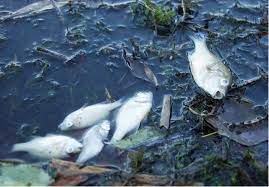The Effects of Water Pollution
Effects of water pollution on human health
The presence of heavy metals such as Fluoride, Arsenic, Lead, Cadmium, Mercury, petrochemicals, chlorinated solvents, pesticides and nitrates in water affects human health (Singh and Gupta 2016)..
Fluoride in water is essential for protection against dental carries and weakening of the bones. Concentration below 0.5 mg/l causes dental carries and mottling of teeth but exposure to higher levels above 0.5 mg/l for 5-6 years may lead to adverse effect on human health leading to a condition called fluorosis (Singh and Gupta 2016).
Arsenic is a very toxic chemical that reaches the water naturally or from wastewater of tanneries, ceramic industry, chemical factories and from insecticides such as lead arsenate, effluents from fertilizers factories and from fumes coming out from burning of coal and petroleum.
Arsenic is highly dangerous to human health causing respiratory cancer, arsenic skin lesion from contaminated drinking water in some districts of West Bengal, India. Long exposure leads to bladder and lungs cancer.
Read Also : How to Locate Electronic Recycling Near Me
Lead is implicated in contaminated drinking water source from pipes, fitting, solder, household plumbing systems. In human being, it affects the blood, central nervous system and the kidneys. Child and pregnant women are mostly prone to lead exposure.
Mercury is used in industries such as smelters, manufactures of batteries, thermometers, pesticides, fungicides etc. The best known example of Mercury pollution in the oceans took place in 1938 when a Japanese factory discharged a significant amount of mercury into Minamata Bay, contaminating the fish stocks there. It took several years to show its effects.
By that time, many local people had eaten the fish and around 2000 were poisoned, hundreds of people were left dead and disabled (Akio 1992) and the cause for death was named as Minamata disease due to consumption of fish containing methyl mercury.
It causes chromosomal aberrations and neurological damages to human. Mercury shows biological magnification in aquatic ecosystems.
Cadmium reaches human body through food crop from soil irrigated by affected effluents. Friberg et al. (1974) noted that long term consumption of rice from affected fields by the people living in areas contaminated by cadmium in regions of Japan, resulted into many renal diseases like itai-itai disease, nephritis and nephrosis.
Water borne diseases: Microorganisms play a major role in water quality and the microorganisms that are concerned with water borne diseases are Salmonella sp., Shigella sp., Escherichia coli and Vibrio cholera (Adetunde and Glover 2010).
All these cause typhoid fever, diarrhoea, dysentery, gastroenteritis and cholera. The most dangerous form of water pollution occurs when faeces enter water supply. Many diseases are perpetuated by the faecal-oral route of transmission in which the pathogens are shed only in human faeces (Adetunde and Glover 2010).
Presence of faecal coliforms of E. coliis used as an indicator for the presence of any of these water borne pathogens (Adetunde and Glover 2010).
Larry (2006) suggested that ground water contamination is the leading worldwide cause of deaths and diseases, and that it accounts for the deaths of more than 14,000 people daily, and the majority of them being children under 5 years old.
In recent years, the widespread reports of pollutants in groundwater have increased public concern about the quality of groundwater.
Children are generally more vulnerable to intestinal pathogens and it has been reported that about 1.1 million children die every year due to diarrhoeal diseases (Steiner et al. 2006).
Effects of water pollution on plants
The following are the effects of water pollution on plants according to Singh and Gupta (2016):
Acid deposition: Many acidic substances and aerosols released into the atmosphere from industrial or domestic sources of combustion from fossil fuels finally fall down to ground and reach the water bodies along with run-off rainwater from polluted soil surfaces thereby causing acidification of water bodies by lowering its pH.
In many countries chemical substances like sulphates, nitrates and chloride have been reported to make water bodies such as lakes, river and ponds acidic.
Nutrient deficiency in aquatic ecosystem: Population of decomposing microorganisms like bacteria and fungi decline in acidified water which in turn reduces the rate of decomposition of organic matter affecting nutrient cycling.

The critical pH for most of the aquatic species is 6.0. The diversity of species decline below this pH whereas the number and abundance of acid tolerant species increases. Proliferation of filamentous algae rapidly forms a thick mat at the initial phase of the acidification of water. Diatoms and green algae disappear below pH 5.8.
Cladophora is highly acid tolerant species and is abundant in acidic freshwater bodies. Macrophytes are generally absent in acidic water as their roots are generally affected in such water resulting in poor plant growth.
Potamogeton pectinalisis found in acidified water. It is observed that plants with deep roots and rhizomes are less affected while plants with short root systems are severely affected in acidic water.
Effects of organic matter deposition: Organic matter from dead and decaying materials of plants and animals is deposited directly from sewage discharges and washed along with rainwater into water bodies causing increase in decomposers / microbes such as aerobic and anaerobic bacteria.
Rapid decomposition of organic matter increase nutrient availability in water favouring the luxuriant growth of planktonic green and blue-green algal bloom.
In addition many of the macrophytes like Salvinia, Azolla, Eicchhornia etc. grow rapidly causing reduced penetration of light into deeper layer of water body with gradual decline of the submerged flora. This condition results in reducing the dissolved Oxygen and increase in the biological oxygen demand (B.O.D). The B.O.D of unpolluted fresh water is usually below 1mg/l while that of organic matter polluted water is more than 400 mg/l.
Effects of agricultural chemicals: Chemicals from fertilizers, pesticides, insecticides, herbicides etc. applied to crops in excess are washed away with rainwater as runoff, then enter into soil and finally arrive at water bodies.
Chemicals from fertilizers result in eutrophication by enrichments of nutrients. Ammonium from fertilizers is acidic in nature causing acidification of water. Similarly pesticides, herbicides and insecticides also cause change in pH of water bodies.
Most common effect of these substances is the reduction in photosynthetic rate. Some may uncouple oxidative phosphorylation or inhibit nitrate reductase enzyme. The uptake and bioaccumulation capacities of these substances are great in macrophytic plants due to their low solubility in water.
Effects of industrial wastes: Effluents from industries contain various organic and inorganic waste products. Fly ash form thick floating cover over the water thereby reducing the penetration of light into deeper layers of water bodies.
Fly ash increases the alkalinity of water and cause reduced uptake of essential bases leading to death of aquatic plants. Liquid organic effluents change the pH of water and the specific toxicity effects on the aquatic plants vary depending on their chemical composition.
There may be synergistic, additive or antagonistic interactions between metals with respect to their effects on plants however these effects are reduced in hard and buffered freshwater bodies.
Effects of silt deposition: Deposition of silt in water bodies occurs as a result of erosion carrying silt laden water. It increases the turbidity of water and reduces light penetration in deep water causing decline in abundance of submerged plants.
Siltation inhibits the growth of aquatic plants. Abundance of phytoplankton is affected due to reduction in surface exchange of gases and nutrients. Plants that are tolerant to turbidity are abundant followed by those that are intermediate and the least tolerant species. Plants such as Polygonum, Sagittariaetc. are found to grow in dominance.
Phytotoxicity effects on plants: When chemical pollutants build up in aquatic or terrestrial environments, plants can absorb these chemicals through their roots. Phytotoxicity occurs when toxic chemicals poison plants.
The symptoms of phytotoxicity in plants include poor growth, dying seedlings and dead spots on leaves. For example, mercury poisoning which many people associate with fish can also affect aquatic plants, as mercury compounds build up in plant roots and bodies result in bioaccumulation.
Read Also : Hurts Wastewater Management Complete Guide
Effects of oil spillage: Oil pollution due to spillage of oil tankers and storage containers prevents oxygenation of water and depletes the oxygen content of the water body by reducing light transmission inhibiting the growth of planktons and photosynthesis in macrophytes.
Eutrophication: Nutrient enrichment in aquatic water bodies leads to eutrophication which is a process whereby water bodies receive excess inorganic nutrients, especially Nitrogen and Phosphorus, stimulating excessive growth of plants and algae.



